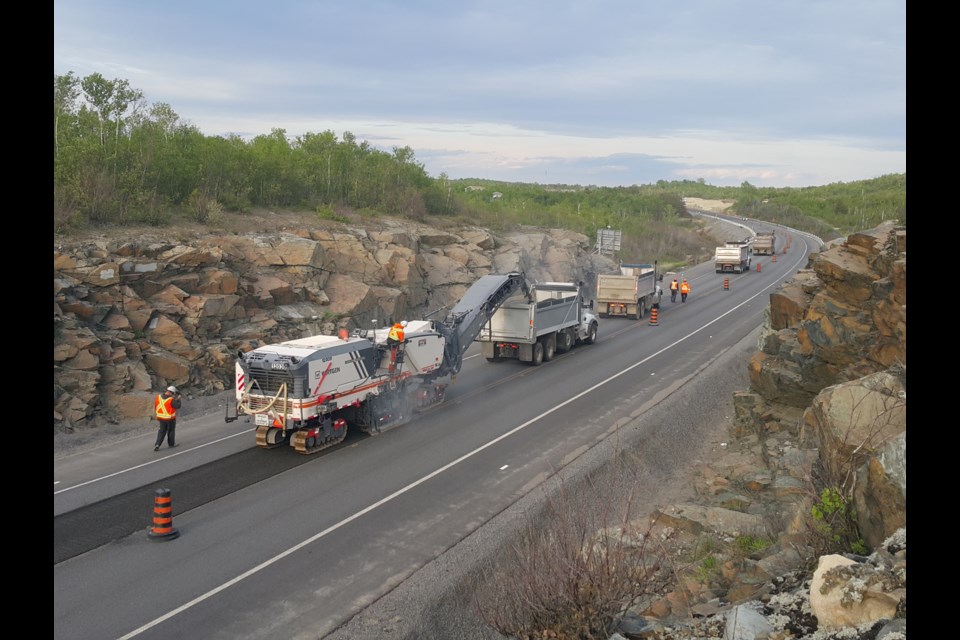Having finished rehabilitating a five-kilometre stretch of Highway 17 days ahead of schedule, it’s clear a relatively new-to-Canada 3D-scanning model is living up to its hype.
The Highway 17 project south of Sudbury was started on June 1 near the southwest bypass from Hannah Lake to Highway 69. Construction crews finished work on June 4.
In the North, it’s said there are two seasons: winter and construction. Northerners are in the thick of construction season right now, and road projects are in full swing. No matter where you go, motorists are sure to be stuck in a lineup of traffic at some point, perhaps for long periods of time. For Northerners, it has become commonplace.
What set this particular project apart from others is the fact it utilized a three-dimensional milling model established by Control Systems CA, a Czech company that is making inroads in Canada and has completed similar projects around the world, said spokesperson Antonio Bauce, who works for the Consulate General of the Czech Republic in Toronto.
Bauce said the technology has the potential to cut construction time by 25 per cent, reducing the amount of time motorists have to wait in lineups, as well as cost and carbon footprint of road rehabilitation projects.
Essentially, by using this model, construction companies can ensure roadways are milled to their optimal crossfall prior to resurfacing, allowing for proper drainage of water off the pavement, and will also ensure only necessary asphalt is removed during rehabilitation, effectively reducing construction time and excessive surplus materials.
It all sounds rather technical, but really it’s a simple idea, said Bauce.
“Prior to any road work, this technology can run scans to provide an in-depth profile of the road, down to a millimetre precision, and will detail such issues as soft spots or potential risks for water pooling,” said Bauce.
Once Control Systems CA acquires that data through its scans, that information is relayed to the milling operators and machines automatically.
Reduced construction time and a reduction in surplus materials results in direct cost savings that normally exceed 15 per cent of associated milling costs, said Bauce, who also touted the environmental benefits of lower emissions due to reduced operating time and less trips to the landfill to dispose of used asphalt.
He said the fact the technology puts the asphalt on such a specific slope will be especially important during the winter months, because water pooling on the road can create potentially dangerous situations with buildup of ice.
“It can really mitigate those types of risks,” he said.
Bauce said every project is different, but using the 3D model reduces the amount of milled material being taken by tens of percentages. In past projects, they have calculated milled material being saved by up to 30 per cent.
Last August, Control Systems CA used its model as part of a seven-kilometre road rehabilitation project in Orangeville, and saved 46 per cent of the asphalt from going to the dump, Bauce said.
Ninety-nine per cent of road rehabilitation in Canada does not involve any type of scanning, Bauce said. The vast majority are performing the “traditional” milling, or what's referred to as a shave-and-pave, where the machines are set at a depth regardless of whether every section of the road needs to have that much asphalt removed.
“They just kind of blindly take off a set millimetre of asphalt material, and it's a huge waste,” Bauce said. “Often, it's not necessary to take that much off, but the crews just don't know because they don't have that data available to them.”
There is obvious savings in terms of public money and the beneficial impact on the environment, but the model is not being utilized by the Ministry of Transportation on a wide scale, Bauce said.
“But it really should be, if the main concern is saving money and time, reducing CO2 emissions and making a better road,” he said. “If you're just building on top of existing abnormalities and irregularities in the pavement, you're just compounding the issue and you never solve it. With this tech, you solve it in one step.
The company is trying to get more attention toward airport runways in Canada, because their precision in creating a well-profiled road is unparalleled, Bauce said. Last year, the company did a rehabilitation of Stockholm's airport, and this year they have secured a contract to improve Prague's runways.




